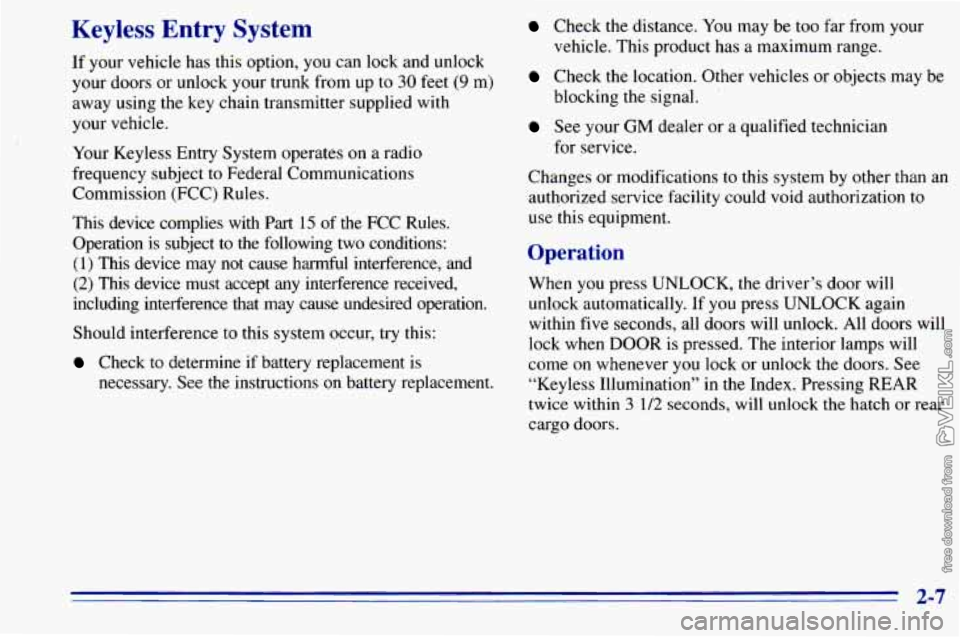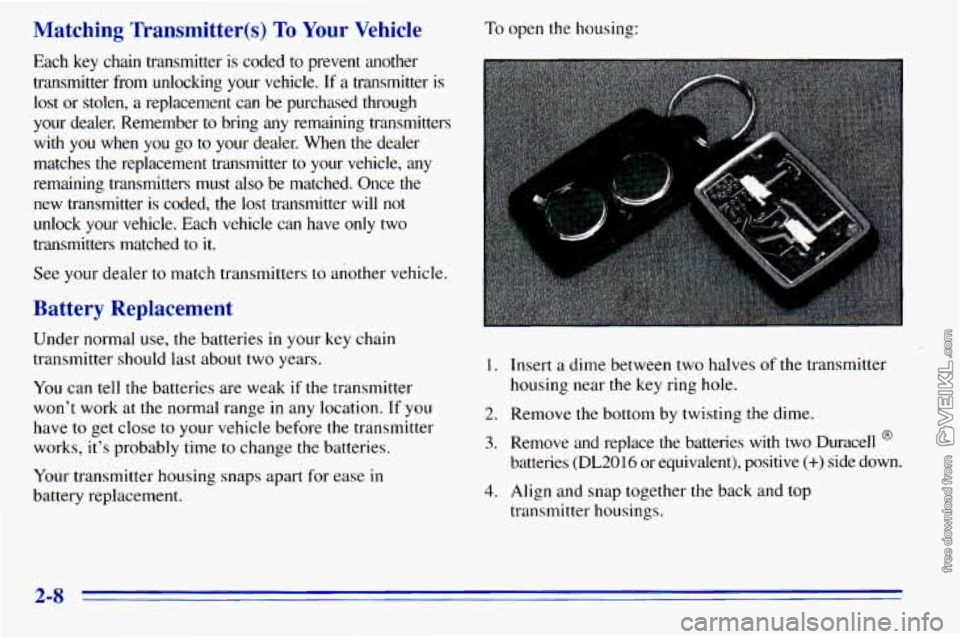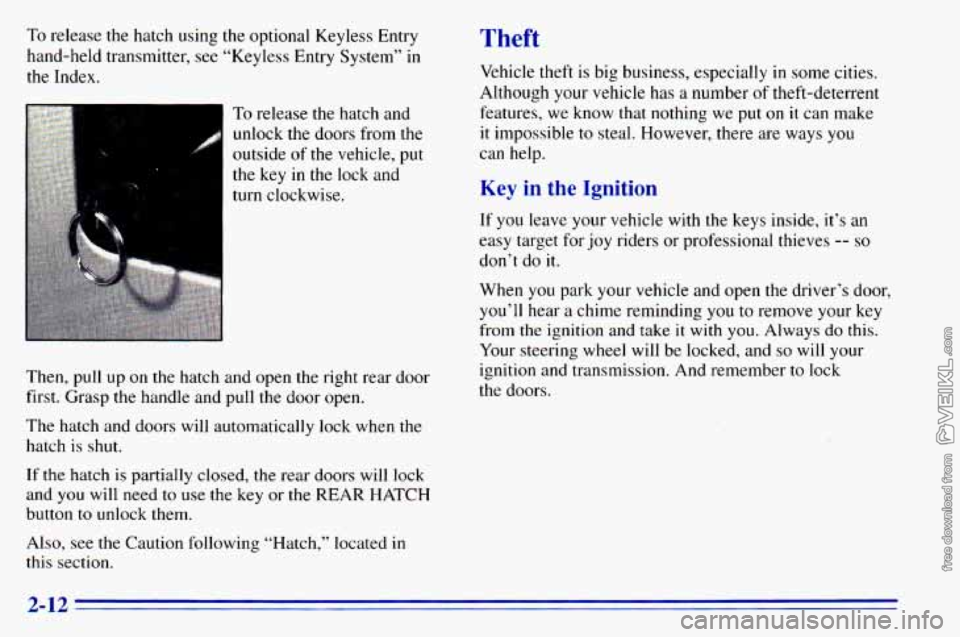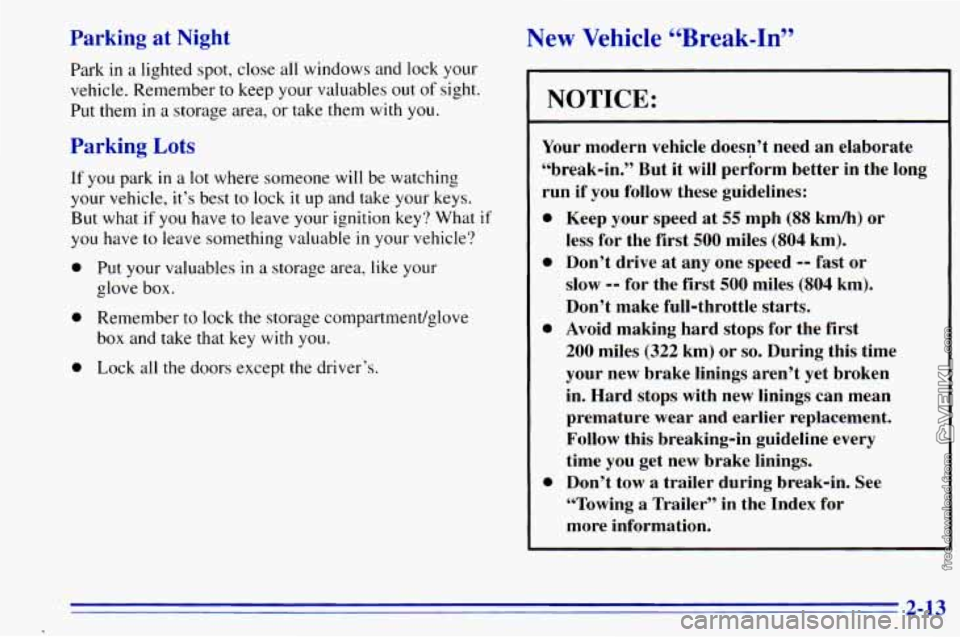1996 CHEVROLET ASTRO lock
[x] Cancel search: lockPage 67 of 372

Keyless Entry System
If your vehicle has this option, you can lock and unlock
your doors or unlock your
trunk from up to 30 feet (9 m)
away using the key chain transmitter supplied
with
your vehicle.
Your Keyless Entry System operates on a radio
frequency subject to Federal Communications
Commission (FCC) Rules.
This device complies with
Part 15 of the FCC Rules.
Operation
is subject to the following two conditions:
(1) This device may not cause harmful interference, and
(2) This device must accept any interference received,
including interference that may cause undesired operation.
Should interference to this system occur, try this:
Check to determine if battery replacement is
necessary. See the instructions on battery replacement.
Check the distance. You may be too far from your
vehicle. This product has a maximum range.
Check the location. Other vehicles or objects may be
blocking the signal.
See your GM dealer or a qualified technician
for service.
Changes or modifications to this system by other than
an
authorized service facility could void authorization to
use this equipment.
Operation
When you press UNLOCK, the driver’s door will
unlock automatically. If you press UNLOCK again
within five seconds, all doors will unlock.
All doors will
lock when
DOOR is pressed. The interior lamps will
come on whenever you lock or unlock the doors. See
“Keyless Illumination’’
in the Index. Pressing REAR
twice within
3 1/2 seconds, will unlock the hatch or rear
cargo doors.
2-7
Page 68 of 372

Matching Transmitter(s) To Your Vehicle
Each key chain transmitter is coded to prevent another
transmitter from unlocking your vehicle. If
a transmitter is
lost or stolen, a replacement can be purchased through
your dealer. Remember to bring
any remaining transmitters
with you when
you go to your dealer. When the dealer
matches the replacement transmitter to your vehicle, any
remaining transmitters must also be matched. Once the new transmitter is coded, the lost transmitter will
not
unlock your vehicle. Each vehicle can have only two
transmitters matched to
it.
See your dealer to match transmitters to another vehicle.
Battery Replacement
Under normal use, the batteries in your key chain
transmitter should last about two years.
You can tell the batteries are weak if the transmitter
won’t work at the normal range
in any location. If you
have
to get close to your vehicle before the transmitter
works, it’s probably time
to change the batteries.
Your transmitter housing snaps apart for ease
in
battery replacement.
To open the housing:
1. Insert a dime be een two halves of the transmitter
housing near
the Key ring hole.
2. Remove the bottom by twisting the dime.
3. Remove and replace the batteries with two Duracell @
batteries (DL2016 or equivalent), positive (+) side down.
4. Align and snap together the back and top
transmitter housings.
2-8
Page 70 of 372

Sliding Door Child Security Lock
Your vehicle’s sliding side
door is equipped with
a
child security door lock,
located at the rear of the
sliding door, near the side
door latch mechanism. This
feature prevents passengers from opening the
sliding side door from
the inside.
To use this feature, do the following:
1. Move the lever all the way up. (Arrow is pointing to
the lever that you must move.)
2. Close the door.
To open
the sliding side door while the child security
lock is engaged, unlock the door and open it from
the outside.
If
you don’t cancel the security lock feature, adults or
older children who ride
in the rear won’t be able to open
the sliding door from the inside.
You should let adults
and older children know how the security door lock
There are
two labels on your vehicle to remind you that works, and how to cancel the lock,
you have this feature. One can be
seen from the outside
on your sliding door. It is located near the bottom
of the Canceling the Sliding Door Child
door glass, toward the rear of the door. The other label is Security Lock
at the back of the sliding door, near the child security
door lock.
To cancel the child security lock:
1. Unlock the door and open it from the outside.
2. Move the lever all the way down.
2-10
Page 71 of 372

Hatch
A CAUTION:
It can be dangerous to drive with the rear
swing-out windows, rear hatch or rear doors
open because carbon monoxide (CO) gas can
come into your vehicle. You can’t see or smell
CO. It can cause unconsciousness and even death.
If you must drive with the rear swing-out
windows, rear hatch or rear doors open or
if
electrical wiring or other cable connections must
pass through the seal between the body and the
rear swing-out windows, rear hatch or rear doors:
Make sure all windows are shut.
’hrn the fan on your heating or cooling
system to its highest speed with the setting
on anything but MAX A/C. That will force
outside air into your vehicle. See “Comfort
Controls” in the Index.
instrument panel, open them all the way.
If you have air outlets on or under the
See “Engine Exhaust” in the Index.
Rear Hatch and Dutch Doors Release
(Option)
If you have this option, your vehicle must be in either
PARK (P) or NEUTRAL
(N) to release the hatch and
unlock the Dutch doors. If your battery
is dead, the
hatch and Dutch doors will not open,
even from the
outside with a key.
To release the hatch and
unlock the doors from the
inside of the vehicle, press
the REAR HATCH button
on the instrument panel.
It
is located on the right side of the steering column. The
hatch will release with or without the key
in the ignition.
Then, pull up on
the hatch handle and open the doors.
2-11
Page 72 of 372

To release the hatch using the optional Keyless Entry
hand-held transmitter, see “Keyless Entry System”
in
the Index.
To release the hatch and unlock the doors from the
outside
of the vehicle, put
the key in the lock and
turn clockwise.
Then, pull up
on the hatch and open the right rear door
first. Grasp the handle and pull the door open.
The hatch and doors will automatically lock when the
hatch is shut.
If
the hatch is partially closed, the rear doors will lock
and you will need to use the key or the REAR HATCH
button to unlock them.
Also, see the Caution following “Hatch,” located in
this section.
Theft
Vehicle theft is big business, especially in some cities.
Although your vehicle has a number
of theft-deterrent
features, we know
that nothing we put on it can make
it impossible
to steal. However, there are ways you
can help.
Key in the Ignition
If you leave your vehicle with the keys inside, it’s an
easy target for joy riders or professional thieves
-- so
don’t do it.
When you park your vehicle and open the driver’s door,
you’ll hear a chime reminding
you to remove your key
from the ignition and take
it with you. Always do this.
Your steering wheel will be locked, and
so will your
ignition and transmission. And remember to lock
the doors.
2-12
Page 73 of 372

Parking at Night
Park in a lighted spot, close all windows and lock your
vehicle. Remember to keep your valuables
out of sight.
Put them
in a storage area, or take them with you.
Parking Lots
If you park in a lot where someone will be watching
your vehicle,
it’s best to lock it up and take your keys.
But what if you have to leave your ignition key? What if
you have to leave something valuable in your vehicle?
0 Put your valuables in a storage area, like your
glove box.
0 Remember to lock the storage compartment/glove
0 Lock all the doors except the driver’s.
box and take that key
with you.
New Vehicle “Break-In”
NOTICE:
Your
modern vehicle doesn’t need an elaborate
“break-in.” But it will perform better in the long
run if you follow these guidelines:
0
0
0
0
Keep your speed at 55 mph (88 kmk) or
less for the first
500 miles (804 km).
Don’t drive at
any one speed -- fast or
slow
-- for the first 500 miles (804 km).
Don’t make full-throttle starts.
Avoid making hard stops for the first
200 miles (322 km) or so. During this time
your new brake linings aren’t yet broken
in. Hard stops with new linings can mean
premature wear and earlier replacement.
Follow this breaking-in guideline every
time you get new brake linings.
Don’t tow
a trailer during break-in. See
“Towing
a Trailer’’ in the Index for
more information.
2-13
Page 74 of 372

Ignition Positions
Use your ignition key to start your vehicle. The ignition key \
lets you turn the ignition switch
to five different positions.
C
ACCESSORY (A): This position lets you use things like
the radio and the windshield wipers when the engine is
off. To get into ACCESSORY, push in the key and turn
it toward
you. Your steering wheel will remain locked,
just as it was before
you inserted the key.
NOTICE:
Don’t operate accessories in the ACCESSORY
position for long periods
of time. Prolonged
operation of accessories in the ACCESSORY
position could drain your battery and prevent
you from starting your vehicle.
LOCK (B): This position locks your ignition, steering
wheel and transmission shift lever
in PARK (P). It’s a
theft-deterrent feature. You will only be able to remove
your key when the ignition is turned to
LOCK.
OFF (C): This position lets you turn off the engine but
still turn the steering wheel. Use
OFF if you must have
your vehicle in motion while the engine is off (for
example,
if your vehicle is being towed).
RUN (D): This is the position for driving.
START (E): This starts your engine.
Page 75 of 372

NOTICE:
If your key seems stuck in LOCK and you can’t
turn it, be sure it is all the way
in. If it is, then
turn the steering wheel left and right while you
turn the key hard. But turn the key only with
your hand. Using a tool to force it could break
the key or the ignition switch.
If none of this
works, then your vehicle needs service.
Starting Your Engine
Move your shift lever to PARK (P) or NEUTRAL (N).
Your engine won’t start
in any other position -- that’s a
safety feature.
To restart when you’re already moving,
use NEUTRAL (N) only.
NOTICE:
Don’t try to shift to PARK (P) if your vehicle is
moving. If you do, you could damage the
transmission. Shift to PARK (P) only when your
vehicle is stopped.
1. Without pushing the accelerator pedal, turn your
ignition key
to START. When the engine starts, let
go of the key. The idle speed will go down as your
engine gets warm.
I
NOTICE:
Holding your key in START for longer than
15 seconds at a time will cause your battery to be
drained much sooner. And the excessive heat can
~
damage your starter motor. ,
I
2-15